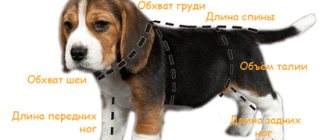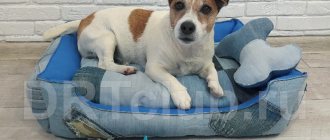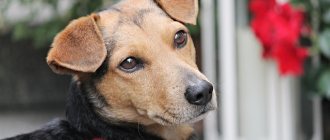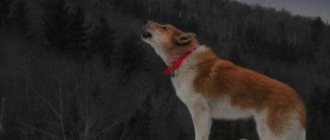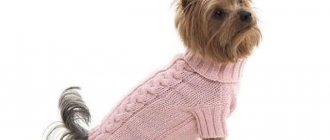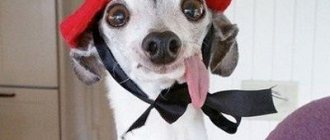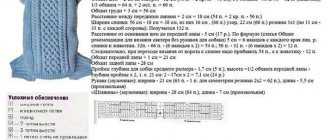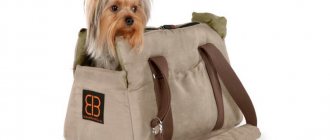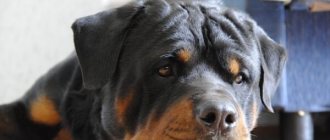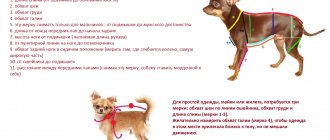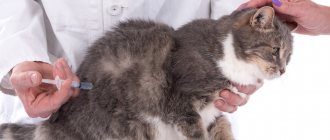Some dog breeds require additional protection and clothing. The point is not only that they need to stay warm when walking in winter or other cold seasons. Sometimes it is important to have protection if they have recently had surgery. This applies mostly to pets with short hair. The most suitable option for dogs of all breeds and sizes is a blanket. It can prevent dirt from getting into wounds, keep you warm in winter and at the same time allow your pet to move freely without restricting its movement. The idea of creating this type of clothing initially appeared among horse breeders, but migrated and took root among dogs and cats. This article will describe in detail how to make a blanket for a dog with your own hands, patterns for similar products, how to take measurements from a dog and much more.
How to take measurements from a dog
Sewing clothes for dogs and other animals is similar to the process of sewing for humans. It is also necessary to take measurements, since clothes that are too narrow or wide will hinder movement or, conversely, drag on the ground.
You can make a bandage for a dog yourself
To take measurements of a dog, it must be placed on a horizontal and straight surface so that it stands stable and straight, with all four paws touching it. To do this, the dog is calmed down. You can even feed her in the process. In the process of taking measurements, it is necessary that the centimeter does not lie too closely to the body, but does not sag. This means that when wrapping, the tape should move calmly in different directions.
Sequence of taking measurements
The main measurements for sewing and knitting are:
- Back length.
- Neck circumference.
- Chest circumference.
- Waist circumference.
- Distance from front to rear paws.
- Distance between front paws.
- The length of the front and rear legs (from the armpits to the surface on which the dog is standing).
- Distance from the armpits of the front paws to the genitals (only for males).
You might be interested in: Making simple patterns for wraparound robes
DIY clothes for cocker spaniel
How to knit a cape yourself
If you know how to use knitting needles and crochet well, then it’s worth creating an insulated blanket for the autumn-winter season completely on your own. The easiest shapes in this case will be such shapes as a triangle or a rectangle with an already created hole for the pet’s tail.
If you know how to knit complex types of things , then you can create a blanket according to the following instructions.
Dimensions
- ОШ (neck circumference).
- DI (length of the entire product).
- The distance from the collar to the middle of the product itself.
- The total width of the jumper in the abdominal area (this value will depend on the breed and size of the dog).
- 2/3 OR.
- 2/3 OG (pet's chest circumference).
- 1/3 OG with the addition of a few centimeters.
- The total width of the collar (this value will be calculated by eye and will also directly depend on the size of the dog).
- Elements for fastening from two to four centimeters.
Knitting process
It should start with the collar. To begin with, the required number of loops is cast (the calculation should be made using a pre-prepared pattern), equal to the volume of the dog’s neck. We continue to knit the collar with a simple elastic band two by two or one by one, you can use another parameter that suits you best.
You should close about a third of the volume of the neck loops and start knitting the back area. If you want, you can knit it with a beautiful pattern, but if not, then you should knit it with simple knit stitches, after which you can decorate the back with special embroidery. Along the edges of the subsequent second rows, you should make one yarn over at a time, so that you ultimately end up with a trapezoid.
After the width of what is done reaches two-thirds of the chest circumference, you can continue knitting without making a yarn over. 10-12 cm before the end of the product, it is worth starting the process of decreasing the loops, tying them in two at the end of every second row. If you want the cape to become rectangular, then you don’t have to remove it.
In this case, the belt is knitted separately. It can be knitted with the same type of elastic as the collar itself, or it can be knitted with simple knit stitches. The belt, as well as the fastening element itself, should be sewn on the sides of the clothing itself. In order to secure the belt, you can purchase buttons or simple Velcro.
How to sew a blanket for a dog with your own hands: step-by-step instructions
When all materials and tools are prepared, you can start sewing. To do this, the pattern details are transferred to the fabric: main and lining. Don't forget to leave a 1 centimeter allowance at the edges.
Important! Each pattern piece is half a piece. That is why, when a person begins to transfer the pattern onto the fabric, it is necessary to fold it in half and apply the part to the fold with the corresponding line.
A jumpsuit or blanket after surgery is very important for maintaining health.
When all the parts are cut, they need to be unfolded. The lining can be made in such a way that it completely copies the base, or it can be done a little differently. Naturally, the top of the dog’s body receives most of the precipitation in winter or autumn, so the back should be lined with membrane or waterproof fabric. After this, the two parts are sewn together, and the unstitched holes are left for turning the product inside out.
It is best to sew the back parts along the neck, and the lower and side parts to the notches that will meet at the neck. The belly is stitched almost completely, turned inside out and stitched. All that remains is to stitch the lining so that it does not stick out, and turn out all the parts that are sewn together to complete the process. For fixation, it is best to use sewn-in elastic bands or Velcro.
Postoperative blanket diagram
How to sew elbow pads for a dog
These parts serve as protection for the paws of dogs who prefer to constantly lie on hard surfaces. First of all, these are home clothes and you need to take them off before going outside. They prevent the appearance of calluses, and if they already exist, then no infection will get into the wounds.
It is best to order flexible and stretchy accessories made of synthetic material, but you can make them yourself. To do this, you should use children's tights or sweaters that have good elasticity. It all depends on the size of the dog. Calluses are typically found in larger breeds.
Dog elbow pads
What do we need
As I already wrote, the choice of materials depends on the purpose of the blanket. But today we are not looking at a warm winter blanket for a dog, but a light raincoat for cloudy weather.
So, to make a raincoat blanket we will need the following materials:
- Water-repellent, lightweight, breathable membrane fabric.
- Lining fabric.
- Velcro, buttons or strap for fastening (your choice).
Pattern of a cap for a dog
First you need to take the necessary measurements: the length from the eyes to the base of the head along the top of the head. To this value add 2.5 centimeters for the bend of the fabric. The second measurement is similar, but measured between the ears. 5 millimeters of allowance are also added on each side. The last measurement is the circumference of the head with the forehead and chin. This parameter is divided by 4 and multiplied by 3. Also, an increase of 2.5 centimeters is added on each side for seams and bends of the material.
You might be interested in this: The procedure for constructing patterns for men's shirts
Pattern of a cap for a dog of any size
Important! Next, we begin making the pattern. It is shown in the picture below. It is applied on paper with a millimeter square. The visor and its length are made at will. After the drawing is ready, it is cut out and the pattern is ready.
Measurements for a dog vest
Vest for a dog - pattern
For the vest you will also need to take several measurements:
- Chest circumference at its widest point.
- Neck circumference at the base.
- Length of the back from the base of the tail to the withers. Measured only in a quiet stance.
The last value is needed to determine the side of the square of the drawing. The length of the back is divided by 10. This will be the size of the square for the pattern. After measurements, it is necessary to accurately transfer all the details onto the grid.
The vest replaces pants and a T-shirt
For production you will need:
- Lining stitch. Usually this is fabric on padding polyester.
- Membrane material that “breathes” and has water-repellent properties.
- Zipper or special Velcro. It is best to use the first option.
You can take the pattern on the Internet or build it yourself if you have the appropriate experience. After this, all the details of the drawing are transferred to the fabric. Do not forget about allowances of 1 centimeter.
Important! If the drawing from the Internet says “fold line,” then the part must be applied to a piece of fabric folded in half. In this case, the conditional line should lie at the very place of the fold.
You need to sew the vest along the side marks
The lower part should be cut with a fold, and the back should consist of two parts. The lining is cut so that it completely copies the details of the membrane fabric. After cutting, the lining and base parts are sewn on the sides from the inside out. The lining and membrane are connected with the front parts and stitched along the bottom of the vest and along the sections for the sleeves.
All this is turned right side out and darned with a finishing stitch along the bottom of the product and the edges. The shoulder sections are swept away, and the resulting design is applied to the dog. Now is the time to determine whether the vest is suitable and change it.
You might be interested in this: The most beautiful knitwear dress patterns
Important! It is worth making sure that the vest fits well on the dog, is not too tight for him, and that the armholes do not put pressure on the armpits. Otherwise, they may chafe and make your dog uncomfortable. If everything is fine, then the vest is sewn on a sewing machine.
The vest protects from cold and rain
Types of blankets
Capes vary in size, shape and function. Depending on the purpose they are:
- cooling for hot weather;
- for the winter period;
- for demi-season weather;
- postoperative.
Cooling
In summer, animals, like people, suffer from the heat. For pregnant, elderly or sick animals, and puppies, overheating can be fatal. A cooling blanket will be a real relief for them. Before a walk, the cape should be moistened with cold water, wrung out a little and put on the dog. The blanket will remain cool for about an hour.
You can buy such a product at a pet store or sew it yourself from cooling bedding.
Winter cape
The winter blanket is intended to protect the dog from hypothermia after active games in the winter. There are a number of requirements for such capes:
- It should be made of dense, wear-resistant material that protects from wind and rain (soft drape, artificial or natural fur, nylon, wool).
- The padding is a natural fabric (fleece, cotton, microfiber) that absorbs sweat well.
- It is advisable that another layer of padding polyester or fleece be used.
- Velcro is not suitable for winter models, since they do not work at sub-zero temperatures. Capes with buttons are recommended.
It is advisable that winter models have a hood.
If we compare a blanket with a winter overall, it has a number of advantages:
- It is more convenient to put on.
- It's easy to choose the right size. You just need to measure the length from neck to tail. The width can be adjusted using straps.
- The animal feels more free. The cape does not interfere with active games.
At the same time, you need to know that dogs that get cold quickly or have weak immunity are recommended to wear overalls. It will protect not only your back, but also your sides, chest, and paws from the cold.
Demi-season
A lightweight polyester cape is ideal for spring and autumn. It will protect the dog from rain and dirt, provided that the animal walks along paved paths and not through a forest or park. In this case, it is recommended to choose more protective overalls.
If your dog is sensitive to the cold, you can wear overalls and a blanket with water-repellent properties on top.
Postoperative
A cape for dogs after surgery is a necessity because it protects stitches or wounds from infection. The animal tries to lick the wound, which must be in a neutral environment for rapid healing.
It has special requirements:
- It is made from breathable natural fabric that will fit snugly, but will not put pressure on the seam or wound (cotton, chintz).
- The bandages are placed on the back so that the dog cannot untie them with his teeth or claws. Therefore they must be well sewn.
- Do not restrict movements.
To treat the wound, there is no need to completely remove the blanket; it is enough to untie only a few ties. But at the same time, a large number of ties can cling to various objects, so it is recommended to carefully monitor the dog. If the dog still tears the cape, then you can put a collar on it.
Medical blankets can be purchased ready-made, but you need to know that you will need several of them to change them (contaminated capes should be washed and ironed with a hot iron). Therefore, you can sew a postoperative blanket for dogs with your own hands.
How to sew a muzzle for a dog with your own hands
For sewing you will need:
- Centimeter.
- Materials for the pattern: paper, ruler, marker or pencil.
- Materials for the product: thick canvas (tarpaulin), fasteners and straps.
The measurements are:
- The circumference of the muzzle is above the nose.
- The circumference of the muzzle near the bridge of the nose.
- The length of the muzzle from the bridge of the nose to the nose.
- Length from the middle of the nose to the straps.
- Head circumference from the muzzle.
Full muzzle for a dog
The pattern is quite simple to construct, and after cutting it out, you can immediately try on the future muzzle on the dog. It is important to make sure that the straps of the product pass clearly along the muzzle and do not touch the ears.
Next, the paper details are transferred to the fabric. For convenience, you can fold the fabric in half, like the pattern itself. This will minimize the transfer process, since the product is symmetrical. As a result, you get two parts for a muzzle and a strap, to which you can sew a strap. This is necessary to compact the fabric and increase reliability.
Measurements for the muzzle pattern
Patterns for dogs from Svetlana Kovaleva
Patterns and drawings of clothing for dogs from Svetlana Kovaleva are especially popular on the Internet. The woman lives in Pokrovsk in Ukraine and makes some of the best custom clothing patterns for dogs of all types. Below are several works of the business master.
Overalls for small breed dogs
Above, it was described in detail how to make knitted clothes for dogs of small and large breeds with your own hands, and patterns of similar products are presented. Sewing such clothes is simple and does not take much time, and it will be very useful for your pet in cold weather or when sick.
Why do you need a blanket?
A blanket is an important item in the wardrobe of large and small dogs. It has a number of advantages:
- it is convenient to take off and put on;
- width is adjustable using straps or Velcro;
- in a blanket the dog feels free, nothing hinders its movements;
- the product does not get wet and is easy to wash;
- in autumn and spring, a blanket will save you from rain and sleet, and in summer - from overheating;
- a postoperative cape will prevent infection of the wound or suture.
Such capes are especially necessary for small decorative breeds of dogs with short hair that constantly tremble.
